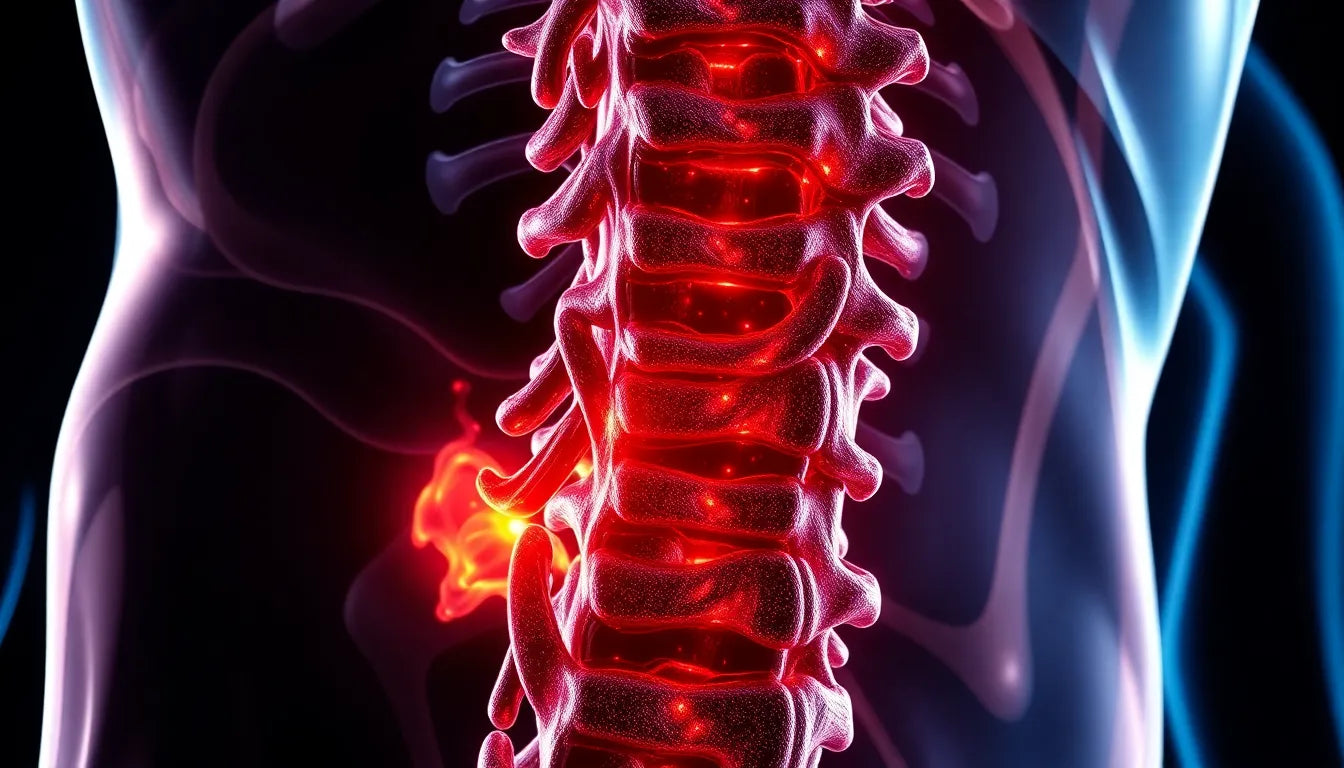For those grappling with a herniated disc in the lower back, achieving a restful night's sleep can be a significant challenge. This common spinal issue often leads to discomfort and pain that can disrupt sleep, impacting overall health and well-being. Understanding the intricacies of this condition and how it affects sleep is crucial for anyone looking to improve their nightly rest and support their recovery process.
understanding the challenge of sleeping with a herniated disc
A herniated disc occurs when the soft center of a spinal disc pushes through a crack in the tougher exterior casing. This can irritate nearby nerves and result in pain, numbness, or weakness in the limbs. When this condition affects the lower back, it can make finding a comfortable sleeping position particularly difficult. The pain and discomfort can lead to frequent waking, tossing and turning, and ultimately, a lack of restorative sleep.
Sleep is a vital component of overall health, playing a significant role in physical recovery, mental well-being, and daily functioning. For individuals with a herniated disc, quality sleep is even more essential as it can aid in reducing inflammation, promoting healing, and improving the body's ability to manage pain. Therefore, addressing sleep challenges is a critical step in managing a herniated disc effectively.
why sleeping positions matter for herniated disc relief
Choosing the right sleeping position can make a substantial difference in alleviating the pain associated with a herniated disc. Proper alignment and support during sleep can help reduce pressure on the affected area, allowing for a more comfortable and uninterrupted rest. On the other hand, incorrect sleeping positions can exacerbate discomfort, leading to increased pain and prolonged recovery times.
Sleeping positions that promote spinal alignment and distribute weight evenly across the body are particularly beneficial. These positions help maintain the natural curvature of the spine, reducing strain on the herniated disc and minimizing pressure on surrounding nerves. By adopting the right sleeping posture, individuals can significantly improve their sleep quality and overall comfort, which is crucial for managing the symptoms of a herniated disc.
In the following sections, we will explore the best sleeping positions for those suffering from a herniated disc in the lower back. By understanding and implementing these strategies, individuals can take proactive steps towards achieving a more restful and pain-free night's sleep.
best sleeping positions for herniated disc relief
When dealing with a herniated disc in the lower back, selecting the right sleeping position is crucial for minimizing pain and promoting healing. One of the most recommended positions is sleeping on your back. This position is often considered optimal because it allows for even weight distribution across the body, which helps maintain a neutral spine alignment and reduces pressure on the herniated disc.
sleeping on your back
Sleeping on your back is beneficial because it supports the natural curvature of the spine and minimizes strain on pressure points. To enhance the comfort and effectiveness of this position, there are several tips you can follow:
- Use a pillow under the knees: Placing a pillow under your knees helps maintain the natural curve of your spine, reducing pressure on the lower back.
- Consider additional lumbar support: A small pillow or rolled-up towel under your lower back can provide extra support, ensuring proper spinal alignment.
- Wedge-shaped pillows: These can be used to elevate your legs and ankles, which may further reduce stress on the lower back.
side sleeping alternatives
For those who find back sleeping uncomfortable, side sleeping can be a viable alternative. Sleeping on your side, particularly on the non-painful side, can offer significant relief. However, it's essential to maintain proper alignment to avoid exacerbating the condition.
side sleeping basics
When sleeping on your side, keeping your knees slightly bent is crucial. This position helps relieve pressure on the spine and supports a more natural alignment.
support techniques for side sleeping
- Pillow between the knees: Placing a pillow between your knees helps maintain proper spinal alignment and reduces strain on the lower back.
- Rolled-up towel for added support: A rolled-up towel between your waist and the mattress can provide additional support, ensuring your spine remains in a neutral position.
fetal position
The fetal position, where you tuck your knees into your chest while lying on your side, can also be beneficial for those with a herniated disc. This position helps reduce spinal bending and opens up joints, which can alleviate pressure on the lower back. Ensure you have proper head and neck support with a suitable pillow to maintain comfort throughout the night.
positions to avoid or modify
While certain positions can provide relief, others may need to be avoided or modified to prevent worsening symptoms. Stomach sleeping is generally discouraged as it can strain the spine. However, if you must sleep on your stomach, consider placing pillows under your stomach and hips to reduce strain. Additionally, a pillow under your forehead can help maintain a more neutral spine position.
By carefully selecting and adjusting your sleeping position, you can significantly improve your comfort and reduce the pain associated with a herniated disc. In the next section, we will explore additional strategies for managing nighttime pain and enhancing sleep quality.
Understanding nighttime pain and the importance of sleep positioning
For individuals with a herniated disc, nighttime can often bring an increase in discomfort. As the body relaxes during sleep, the lack of movement can lead to stiffness and heightened pain. This makes choosing the right sleeping position crucial for minimizing discomfort and promoting healing. Proper sleep posture helps maintain spinal alignment and reduces pressure on the affected area, allowing for a more restful and restorative sleep.
Beyond choosing the right sleeping position, there are additional strategies to manage pain and improve sleep quality. Conservative treatments, such as physical therapy, can provide long-term relief by strengthening the core muscles and improving flexibility. Daytime posture also plays a significant role; maintaining good posture while sitting and standing can reduce strain on the lower back and support recovery.
Additional tips for improved sleep quality
Mattress and pillow selection
The choice of mattress and pillows can significantly impact sleep quality for those with a herniated disc. A supportive mattress that conforms to the body's natural curves can help maintain spinal alignment and reduce pressure points. Memory foam or latex mattresses are often recommended for their ability to provide support and comfort. Additionally, selecting the right pillow to support the neck and head is crucial for maintaining alignment and reducing strain.
Creating a sleep-friendly environment
Creating an optimal sleep environment is essential for enhancing sleep quality. Ensure the bedroom is dark, quiet, and cool, as these conditions promote better sleep. Consider using blackout curtains to block out light and a white noise machine to mask disruptive sounds. Keeping the room at a comfortable temperature can also prevent night sweats and discomfort, contributing to a more restful sleep.
Frequently Asked Questions
What is the best sleeping position for a herniated disc?
The best sleeping position for a herniated disc is on your back, as it allows for even weight distribution and maintains a neutral spine alignment. Using a pillow under the knees can further enhance comfort by supporting the natural curvature of the spine.
Can sleeping on my side worsen my herniated disc?
Sleeping on your side does not necessarily worsen a herniated disc if done correctly. It is important to sleep on the non-painful side with knees slightly bent and a pillow between the knees to maintain proper spinal alignment.
Why does my herniated disc pain worsen at night?
Herniated disc pain can worsen at night due to prolonged periods of inactivity, which can lead to stiffness and increased pressure on the affected area. Proper positioning and support can help alleviate this discomfort.
Are there any specific products that can aid in sleeping with a herniated disc?
Yes, certain products can help improve sleep quality for those with a herniated disc. Supportive pillows, such as memory foam or contour pillows, and mattresses that provide adequate support and comfort, like memory foam or latex, can be beneficial in maintaining spinal alignment and reducing pressure.
By implementing these strategies and selecting the right products, individuals with a herniated disc can significantly improve their sleep quality and overall comfort, supporting their recovery and well-being.
Sources
- Pain and Spine Specialists. "Sleeping Positions for Herniated Disc Relief."
- New York Spine Institute. "Managing Nighttime Pain with Herniated Discs."
- NY Bone and Joint. "Optimal Sleeping Positions for Lower Back Pain."
- Florida Surgery Consultants. "How to Sleep with a Herniated Disc."
- Dr. Kevin Pauza. "Understanding Herniated Disc Pain and Sleep."
- Phoenix Rehab Group. "Effective Sleeping Positions for Herniated Disc Sufferers."


















